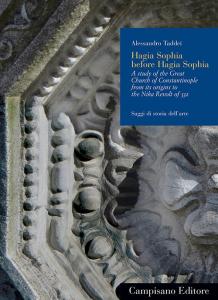Hagia Sophia fefore Hagia Sophia. A study of the Great Church of Constantinople from its origins to the Nika Revolt of 532
CODICE: ISBN 8885795005 EAN 9788885795006
AUTORE/CURATORE/ARTISTA :
Author: Alessandro Taddei
EDITORE/PRODUTTORE : Campisano Editore
COLLANA/SERIE : Saggi di Storia dell'Arte, 52
DISPONIBILITA': Disponibile
TITOLO/DENOMINAZIONE:
Hagia Sophia fefore Hagia Sophia. A study of the Great Church of Constantinople from its origins to the Nika Revolt of 532
PREZZO : EUR 40,00€
CODICE :
ISBN 8885795005
EAN 9788885795006
AUTORE/CURATORE/ARTISTA :
Author: Alessandro Taddei
EDITORE/PRODUTTORE:
Campisano Editore
COLLANA/SERIE:
Saggi di Storia dell'Arte, 52
ANNO:
2017
DISPONIBILITA':
Disponibile
CARATTERISTICHE TECNICHE:
376 pages
B&w illustrations
Paperback
cm 15,5 x 21,5
DESCRIZIONE:
Publisher's description:
La fondazione della Grande Chiesa (Megalê Ekklêsia) di Costantinopoli sia come edificio fisico sia quale sede dell'episcopato della città va fata risalire ai primi mesi dell'anno 360. La nuova chiesa costituiva il coronamento di una vasta operazione religiosa e politica ad un tempo condotta sulla base di uno specifico accordo tra l'autorità imperiale e le locali gerarchie ecclesiastiche. Rappresenta inoltre un importante episodio del patronato artistico del figlio ed erede di Costantino, Costanzo II (337-361). La Grande chiesa di Costantinopoli si rivelò lo strumento attraverso il quale un episcopato avente prestigio ancora limitato – se confrontato con le grandi sedi ecclesiastiche orientali di Antiochia, Alessandria o Gerusalemme – riuscì a rendere visibile il suo crescente potere. Allo stesso tempo, così come era successo in altre grandi metropoli della parte orientale dell'Impero romano, la nuova chiesa episcopale divenne ben presto un simbolo di orgoglio civico e il teatro di confronti e scontri tanto sul piano politico quanto su quello religioso. Tale situazione comporta inoltre una totale identificazione fra le aspirazioni civiche e il simbolo architettonico del potere ecclesiastico locale. Il grande edificio costruito da Costanzo II e restaurato dai sovrani Arcadio (395-408) e Teodosio II (408-450) non solo è scomparso da secoli ma venne peraltro sostituito, sul medesimo sito e solo pochi anni dopo la sua totale distruzione, nel 532, da uno dei maggiori capolavori dell'architettura protobizantina, la Grande Chiesa (Hagia Sophia) dell'imperatore Giustiniano (532-565). È pertanto facile da capire come l'edificio che precedeva quello che oggi possiamo felicemente ammirare sia stato rapidamente dimenticato e relegato all'interno di una nebulosa "preistoria" storiografica. L'obbiettivo di questo volume è di conseguenza quello di studiare le fasi pre-giustinianee della Grande Chiesa non come si trattasse di una preistoria ma come una parte viva di una città nuova, la Costantinopoli protobizantina, città in via di rapida formazione ed espansione.
Contents:
Acknowledgments
Introduction
The Constantinian "prehistory": The Great Church at the dawn of its existence
The context: From the Tetrastoon to the Augustaion
"Eirene", the first episcopal church
Excursus: Tracing early church buildings around the city
The Great Church of Constantius II (360)
Searching for a background
Origin, functions, and name of the new building
From the inauguration of 360 to the fire of 404
The Great Church under Arcadius and Theodosius II
THE REOPENING OF THE GREAT CHURCH
The "indirect patronage" of Arcadius
The "Restless" existence of the Great Church during the fifth century
The archaeology and architecture of the Great Church: Answering difficult questions
Scholarship prior to the first archaeological excavations
Possible models for the church of Constantius II
Discovering the fifth-century church's remains
The portico wall
The wall masonry
The front colonnade and propylon
The floor mosaics
The layout and "identity" of the portico
Investigations beneath the floor of the Justinianic nave
The fifth-century church: An attempt at reconstruction
The façade of the Theodosian portico
Column shafts attributed to the portico wings
Capitals from the portico
Epistyles and sima from the portico trabeation
Column shafts from the propylon
A capital from the propylon
Pilaster capitals from the propylon
The propylon trabeation and ceiling
Door jambs and lintels
Models for the façade of the portico
A note on the Skeuophylakion, the Vizier's Garden and the early baptistery
Excavations in the Vizier's Garden: The northern baptistery
Conclusions
Bibliography
Index
GENERE: Libri ,Saggi ,



